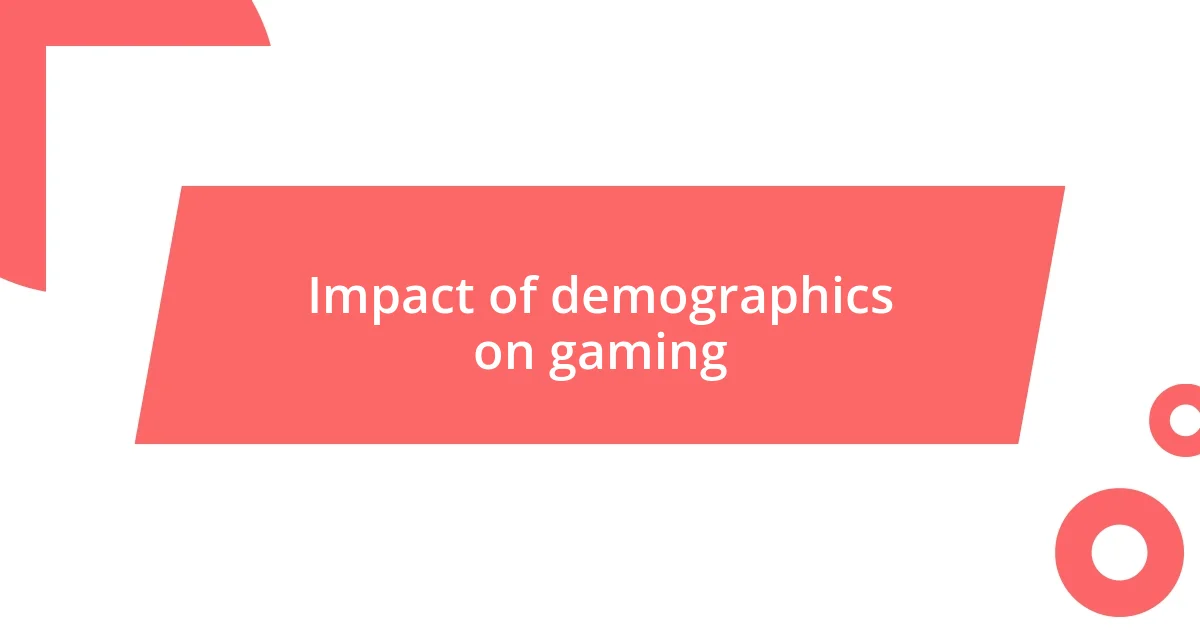Key takeaways:
- Gaming culture diversity is shaped by various factors, including geography, cultural background, technology access, and social dynamics, influencing gameplay styles and community interactions.
- Regional differences in gaming preferences highlight unique cultural approaches, from competitive eSports in South Korea to casual, festive gaming in Brazil, reflecting how location impacts gaming experiences.
- Future trends in gaming emphasize intersectionality in character representation and inclusive design processes, with emerging technologies like VR and AR fostering deeper cultural exploration and understanding among players.

Understanding gaming culture diversity
Gaming culture diversity is a fascinating tapestry woven from countless threads of individual experiences, interests, and backgrounds. I still remember the first time I attended a gaming convention; it was like stepping into a world where every gamer, whether from a different city or country, shared their passion in unique ways. It made me realize just how many perspectives come together in gaming – have you ever thought about how different cultures express their gameplay styles?
Exploring the various subcultures within gaming can feel overwhelming but incredibly rewarding. For instance, I once played with a group from Japan who approached strategy games with a level of depth I hadn’t experienced before. Their emphasis on meticulous planning and aesthetic storytelling changed how I viewed not just the games, but the players themselves. Isn’t it interesting how a single game can offer an entirely different vibe based on the community surrounding it?
The rich diversity encapsulated in gaming culture also reveals much about our society’s values. When I engaged with LGBTQ+ gamers, I was struck by the openness and support they fostered within their communities. It prompted me to reflect on my own experiences in gaming spaces—what if we cherished and celebrated our differences more actively? Understanding these dynamics can deepen our appreciation for not just the games we play, but also the people we play with.

Key factors influencing gaming culture
Diving deeper into the gaming culture, I’ve noticed how geography plays a crucial role in shaping attitudes and preferences. For instance, during an online match with gamers from Europe, I was amazed at their strategic styles, which often differed vastly from my experiences with North American players. The regional differences not only influence gameplay but also how gamers communicate and build camaraderie, making every interaction feel like a cultural exchange.
Several key factors influencing gaming culture include:
- Cultural Background: Different regions bring distinct values and traditions that influence gameplay styles and community norms.
- Technology Access: The hardware and internet availability dictate the types of games played, impacting cultural engagement.
- Social Dynamics: Factors like age, gender, and social status can affect how groups form and interact within gaming spaces.
- Game Design: The way a game is crafted—its mechanics, art style, and narrative—can resonate differently with various cultures, sparking unique interpretations.

Regional differences in gaming preferences
The diversity in gaming preferences varies greatly from region to region, resulting in unique gaming cultures. For example, I once noticed that gamers from South Korea display an intense dedication to competitive play, particularly in eSports. As I participated in a local tournament, the level of passion and fandom was palpable—there was a sense of community that felt almost electric. It made me wonder, have you experienced a similar fervor in gaming with your friends or community?
In contrast, my time gaming with friends in Brazil highlighted a different approach. Casual gaming sessions often turned into festive events filled with laughter and music. Playful banter and shared moments truly defined our experience—everyone was jovial and carefree. This striking difference made me appreciate how regional backgrounds shape not just the games we choose, but the very essence of gaming itself.
Each culture adds its own flavor to the gaming landscape, from the emphasis on narrative depth in Japanese role-playing games to the quick-paced, tactical action games beloved in the U.S. It’s fascinating how a game can feel entirely new based on where you’re playing it. It prompts the question: what are the experiences that define your gaming preferences?
| Region | Common Gaming Preferences |
|---|---|
| South Korea | Competitive eSports, Multiplayer Online Battle Arenas (MOBAs) |
| Brazil | Casual games, Social gaming experiences, Party games |
| Japan | Narrative-rich RPGs, Aesthetic storytelling |
| United States | Action-adventure, First-person shooters (FPS) |

Impact of demographics on gaming
When it comes to the impact of demographics on gaming, one vivid memory stands out for me. Participating in a gaming charity event, I was struck by the wide age range of players. Older gamers brought this incredible sense of history and strategy to the table, while younger players injected an element of innovation and spontaneous creativity. It made me realize how age demographics can create a rich dialogue between generations, transforming gaming from a solitary experience into a shared adventure. Have you ever considered how different age groups influence the way we interact and play together?
Gender dynamics also play a fascinating role in shaping gaming experiences. In one of my gaming sessions, I teamed up with a group of women who were not only skilled but also incredibly supportive. Their camaraderie made me reflect on how inclusivity can redefine the gaming space, encouraging diverse perspectives that might be overlooked in more traditional settings. I started to wonder: how does gender diversity influence your favorite gaming communities?
Lastly, I can’t ignore the profound impact of cultural backgrounds seen in our local gaming meetups. I recall a time when gamers from various ethnic backgrounds came together to explore a newly launched RPG. The conversations around character choices and story arcs were infused with cultural references and values that I hadn’t considered before. This melting pot of ideas not only enriched our gaming experience but also deepened our understanding of each other’s backgrounds. It leads me to ask, how often do we engage with different cultures through the games we love?

Exploring representation in gaming
Exploring representation in gaming is more than just a matter of character inclusion; it’s a way to foster connection and understanding among players. I remember logging into a multiplayer game and spotting a diverse character roster that included a range of ethnicities and genders. It sparked conversations among my teammates about how these representations influenced our gaming experiences. Have you ever felt more connected to a game because of how well it represented you or someone you know?
One particular moment that stands out is when I played a narrative-driven game featuring a protagonist with a disability. The thoughtful and authentic portrayal made me reflect on how rare such representation is in the gaming world. It felt so refreshing to see a character that didn’t conform to traditional hero archetypes. I found myself wondering: how can games continue to push the boundaries of representation to create even richer, more relatable stories?
Moreover, I’ve noticed that when games feature authentic voices and stories from different cultures, it enhances the overall experience. I recall joining an online community dedicated to a game based on African folklore. The discussions about the myths behind the characters were eye-opening, offering insights that I wouldn’t have gained elsewhere. This made me think about the power of storytelling in games—how often do we pause to appreciate the cultural narratives that enrich our gaming journeys?

Future trends in gaming diversity
As I look toward the future of gaming diversity, one trend that excites me is the increasing focus on intersectionality within characters and stories. I recently played an indie game that featured a protagonist who was not only from an underrepresented ethnicity but also identified as part of the LGBTQ+ community. It was a powerful reminder of how multiple identities can coexist and enrich the narrative. Have you ever experienced a game that made you see the world from a completely different perspective?
Another emerging trend is the shift towards more inclusive game design processes. A friend of mine who works in game development shared how her team actively seeks feedback from diverse player groups during the creation phases. This not only allows for richer gameplay but also helps avoid stereotypes—creating experiences that resonate with a broader audience. How do you think this shift could impact the games we see in the next few years?
Finally, I can’t help but notice how the rise of virtual reality (VR) and augmented reality (AR) gaming is opening new avenues for cultural exploration. I had the chance to try an AR game that took cultural history from around the world and immersed players in various landmarks and traditions. The experience sparked questions in my mind about how technology can break barriers and foster understanding among players from different backgrounds. What possibilities do you envision for VR and AR in enriching our appreciation of cultural diversity in gaming?














